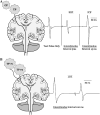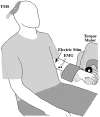Older adults exhibit more intracortical inhibition and less intracortical facilitation than young adults
- PMID: 20417265
- PMCID: PMC2926152
- DOI: 10.1016/j.exger.2010.04.005
Older adults exhibit more intracortical inhibition and less intracortical facilitation than young adults
Abstract
Background: Aging results in decreased neuromuscular function, which is likely associated with neurologic alterations. At present little is known regarding age-related changes in intracortical properties.
Methods: In this study we used transcranial magnetic stimulation (TMS) to measure intracortical facilitation (ICF), short- and long-interval intracortical inhibition (SICI and LICI), motor evoked potential amplitude, and silent period duration in young and older adults (21.4+/-0.8years and 70.9+/-1.8years). These variables were assessed from the flexor carpi radialis muscle of the non-dominant arm under resting conditions, and during a submaximal contraction (intensity 15% maximum strength).
Results: Older adults exhibited increased SICI and LICI in comparison to young adults (SICI: 29.0+/-9.2% vs. 46.2+/-4.8% of unconditioned pulse; LICI: 6.5+/-1.7% vs. 15.8+/-3.3% of unconditioned pulse; P=0.04), and less ICF under resting conditions (74.6+/-8.7% vs. 104.9+/-6.9% of unconditioned pulse; P=0.02). These age-related differences disappeared during contraction, although the older adults did exhibit a longer silent period during contraction (112.5+/-6.5 vs. 84.0+/-3.9ms; P<0.01).
Conclusions: Collectively, these findings suggest increased GABA mediated intracortical inhibition with age.
Copyright 2010 Elsevier Inc. All rights reserved.
Conflict of interest statement
Disclosure statement: The authors have no actual or potential conflicts of interest associated with this work.
Figures




References
-
- Aagaard P, Simonsen EB, et al. Neural adaptation to resistance training: changes in evoked V-wave and H-reflex responses. J Appl Physiol. 2002;92(6):2309–18. - PubMed
-
- Arai N, Okabe S, et al. Comparison between short train, monophasic and biphasic repetitive transcranial magnetic stimulation (rTMS) of the human motor cortex. Clin Neurophysiol. 2005;116(3):605–13. - PubMed
-
- Benwell NM, Mastaglia FL, et al. Differential changes in long-interval intracortical inhibition and silent period duration during fatiguing hand exercise. Exp Brain Res. 2007;179(2):255–62. - PubMed
-
- Butefisch CM, Kleiser R, et al. Post-lesional cerebral reorganisation: evidence from functional neuroimaging and transcranial magnetic stimulation. J Physiol Paris. 2006;99(4–6):437–54. - PubMed
Publication types
MeSH terms
Grants and funding
LinkOut - more resources
Full Text Sources

